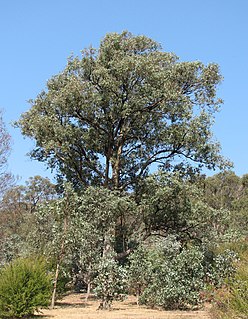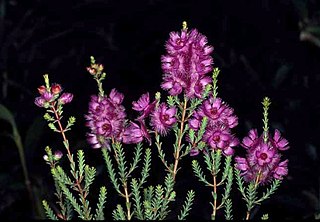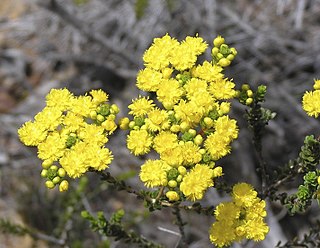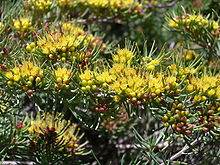
Homoranthus is a genus of about thirty species of plants in the myrtle family Myrtaceae and all are endemic to Australia. Plants in this genus share similarities with those in both Darwinia and Verticordia. They are shrubs with their leaves arranged in opposite pairs and with flowers appearing either singly or in small groups, usually in upper leaf axils. They are found in Queensland, New South Wales and South Australia. The genus was first described in 1836. None of the species is common nor are they well-known in horticulture.

Eucalyptus polyanthemos, commonly known as red box, is a species of small to medium-sized tree, that is native to eastern Australia but has been introduced into other countries. It has fibrous bark on the trunk and larger branches, smooth greyish to cream-coloured bark above, or smooth bark throughout. It has broadly egg-shaped to round juvenile leaves, lance-shaped, egg-shaped or almost round adult leaves, flower buds in groups of seven, white flowers and barrel-shaped to conical fruit.

Verticordia cunninghamii, commonly known as tree featherflower or liandu, is a flowering plant in the myrtle family, Myrtaceae and is endemic to an area in the extreme north of Western Australia and the Northern Territory. It is a spindly shrub or small tree with narrow leaves and cream to white, sweetly scented, feathery flowers.
Johannes Conrad Schauer was a botanist interested in Spermatophytes. He was born in Frankfurt am Main and attended the gymnasium of Mainz from 1825 to 1837. For the next three years he worked at the Hofgarten of Würzburg. Schauer then gained a position as assistant at the botanical garden at Bonn where he worked until 1832 when he was placed in charge of the botanic garden in Breslau, with C.G. Nees. He gained the degree of Doctor of Philosophy at the University of Erlangen-Nuremberg 1835 and was appointed professor of botany at the University of Greifswald from 1843 until his death in 1848.
Verticordia subg. Chrysoma is a botanical name for a grouping of similar plant species in the genus Verticordia.
Verticordia sect. Chrysoma is one of seven sections in the subgenus Chrysoma. It includes four species of plants in the genus Verticordia. Plants in this section are small shrubs with small, bright yellow flowers which usually turn red as they age. They have sepals with fringed lobes and petals which have lobes arranged like the fingers of a hand. The subgenus Chrysoma was originally described in 1843 by Johannes Conrad Schauer and the description was published in Monographia Myrtacearum Xerocarpicarum. When Alex George reviewed the genus in 1991, he took the name of this section from that of the subgenus.

Verticordia is a genus of more than 100 species of plants commonly known as featherflowers, in the myrtle family, Myrtaceae. They range in form from very small shrubs such as V. verticordina to trees like V. cunninghamii, some spindly, others dense and bushy, but the majority are woody shrubs up to 2.0 m (7 ft) tall. The flowers are variously described as "feathery", "woolly" or "hairy" and are found in most colours except blue. They often appear to be in rounded groups or spikes but in fact are always single, each flower borne on a separate stalk in a leaf axil. Each flower has five sepals and five petals all of a similar size with the sepals often having feathery or hairy lobes. There are usually ten stamens alternating with variously shaped staminodes. The style is simple, usually not extending beyond the petals and often has hairs near the tip. All but two species are found in Southwest Australia, the other two occurring in the Northern Territory.

Verticordia drummondii, commonly known as Drummond's featherflower, is a flowering plant in the myrtle family, Myrtaceae and is endemic to the south-west of Western Australia. It is an erect, openly to densely branched shrub with small, narrow leaves and pink to purple flowers in small heads near the ends of the branches.

Verticordia serrata is a flowering plant in the myrtle family, Myrtaceae and is endemic to the south-west of Western Australia. It is a spindly or openly branched shrub with hairy, egg-shaped leaves and flowers which are golden at first, then fade to a greyish colour.
Verticordia sieberi is a flowering plant in the myrtle family, Myrtaceae and is endemic to the south-west of Western Australia. It is a shrub with one main stem, often compact but sometimes openly branched and with pink to pale purple flowers in summer and autumn.
Verticordia sect. Catocalypta is one of eleven sections in the subgenus Verticordia. It includes seven species of plants in the genus Verticordia. Plants in this section are small, bushy shrubs which grow to a height of up to 1 m (3 ft), have thick, fleshy, leaves which are triangular in cross-section. The flowers are arranged in open, corymb-like heads of relatively large flowers. Importantly, their sepals have down-turned, tufts of hair which surround the floral cup.

Calytrix angulata, commonly known as yellow starflower, is a species of plant in the myrtle family Myrtaceae that is endemic to Western Australia.
Calytrix brownii, commonly known as the white turkeybush, is a species of plant in the myrtle family Myrtaceae that is endemic to Western Australia.
Calytrix decandra, commonly known as the pink starflower, is a species of plant in the myrtle family Myrtaceae that is endemic to Western Australia.

Calytrix glutinosa is a species of plant in the myrtle family Myrtaceae that is endemic to Western Australia.

Calytrix sapphirina is a species of plant in the myrtle family Myrtaceae that is endemic to Western Australia.

Homoranthus biflorus is a plant in the myrtle family Myrtaceae and is endemic to a small area in northern New South Wales. It is an erect shrub with cylinder-shaped leaves and small groups of usually yellow flowers.

Homoranthus virgatus is a flowering plant in the family Myrtaceae and is endemic to coastal areas of northern New South Wales. It is an upright shrub with wand-like branches.

Homoranthus bebo is a plant in the myrtle family Myrtaceae and is endemic to a small area in northern New South Wales. It is a low-lying shrub with leaves that are usually flat and with groups of up to ten yellow flowers. It is only known from the Dthinna Dthinnawan Nature Reserve near Yetman.

Homoranthus lunatus is a plant in the myrtle family Myrtaceae and is endemic to a small area in northern New South Wales. It is a spreading shrub with curved leaves and small groups of up to six yellow flowers in leaf axils.














